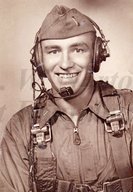
|

|
|
|
|
He was born at home in Lakeport, New York, as one of four children of John Christy Finck and Gladys Gertrude Treen Finck. George's father ran a hotel in Utica, New York, where his mother worked as a waitress. "My father was about thirty years older than my mother," he says. "They ended up getting married and had four children." George recalls a happy childhood during the Depression, living in a 1,400-square foot house near Oneida Lake. His father, however, suffered financially. "We always had a place to sleep and enough to eat," George recalls. "So we were very happy." During World War II his parents worked in war production factories. Although his paternal family was of German ancestry, George recalls no discrimination against them during the war. George graduated from Chittenango High School in 1950, then enrolled at Syracuse University in the College of Forestry. He worked in service stations both in high school and college to help with educational expenses. Although he intended to become a forester, he joined ROTC and was commissioned a second lieutenant in the U.S. Air Force upon graduation. "I had no intention of being a pilot, but I qualified," he recalls, "passed the physical, and next thing I knew they said they're going to send me to pilot training." George reported to Vance Air Force Base in Enid, Oklahoma, where he flew several aircraft, including a B-25. After training he served as an instructor pilot in the C-118, an aircraft in which he flew "between 7,000 and 8,000 hours." On April 11, 1953, while in pilot training, he married a childhood friend, Janet Batten. (They would have four sons, four grandchildren and one great-grandchild.) George qualified in three airplanes: C-118, C-131, and KC-135. He flew many different assignments, including a tour through Africa and into the Middle East. With orders to Vietnam in 1967, George was assigned a C-7A Caribou, an airplane developed for the army, and received training in the aircraft at Sewart Air Force Base near Nashville. "It was the best flying I did in my whole Air Force career," he says. "It was a very easy, forgiving airplane to fly." In Vietnam, he was assigned to the 483rd Tactical Airlift Wing, 458th Tactical Airlift Squadron, commanded by LTC George Rawlings. Based at Cam Ranh Bay Air Base, he re-supplied Special Forces camps. He often flew supplies from 5th Special Forces Group (Airborne) headquarters to many camps, several along the Cambodian border in the central highlands. Some days he made "sixteen, eighteen take-offs and landings." He found living conditions at Cam Ranh Bay "excellent," considering its location in a war zone. He slept in bunk beds, enjoyed air conditioning, and dined in a mess hall. George was awarded the Air Force Cross for a daring night drop of ammunition and medical supplies into Duc Lap when the Special Forces position was surrounded by North Vietnamese infantry. Even while the camp was under heavy mortar attack, he made two drops of supplies, with two crewmembers known as "kickers," who pushed the pallets out. "They were shooting at us," he says of the enemy, recalling how tracers "kind of like they're floating up by you." For his mission, George earned the Air Force Cross, while his two crewmembers received Silver Stars. "When we got back to camp my old knees were shaking so bad!" he recalls. In all, George made 205 sorties, and flew 1,150 hours in combat aerial re-supply time. Often, when flying supplies, he'd never land. He recalls the LAPES (Low Altitude Parachute Extraction System), in which he flew about four feet above a runway and popped the parachute, which pulled the cargo out the back door. Despite his Vietnam missions, he says an earlier event was more frightening. The Cuban missile crisis in 1963 was "the scariest time in my Air Force career," he comments. "At that time, we got down to DEFCON 1. We were right on the brink of a nuclear war," he says. "That was really more scary to me than Vietnam." He recalls leaving his wife and family and thinking, "I didn't know if I'd ever see them again." He was flying U.S. Marine Corps reinforcements into Guantanamo Bay, and picking up dependents to return them to the United States. After Vietnam, George was sent to Hill Air Force Base in Salt Lake City, Utah, where he flew C-118s. He also served as Chief of Air Field Management and Chief of Standard Evaluation. At Griffiss Air Force Base in Rome, New York, a Strategic Air Command (SAC) base, he worked as Chief of Air Field Management, then as Chief of Base Operations and Training. He was then sent to Barksdale Air Force Base in Bossier City, Louisiana, as SAC C-118 Chief Pilot. When he retired in 1978, he was serving as chairman of the Aerospace Science Department at Bowling Green State University in Bowling Green, Ohio, and as Commander of Air Force ROTC. The family returned to Shreveport where he worked as personnel officer at LSU Medical Center. He created the Air Force Junior ROTC at Haughton High School, commanding the unit for sixteen years until he retired again in 1998. "For a number of years it was the largest Air Force Junior ROTC unit in the country," he says. Throughout his air force career, George says he flew more than 11,000 hours. He served two terms on Bossier City School Board, including one term as president. George is a member of the American Legion, and is active with Boy's State and the Arklatex Chapter of the Military Officers Association of America. |


